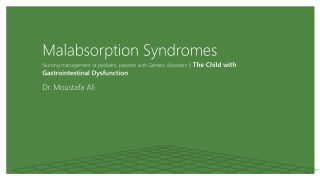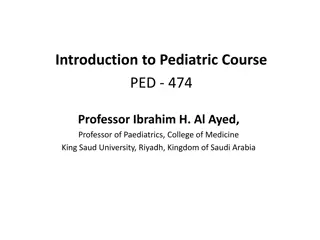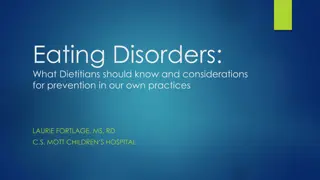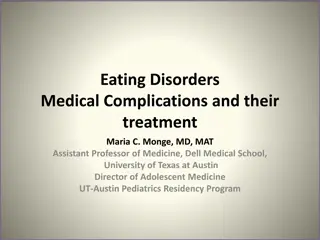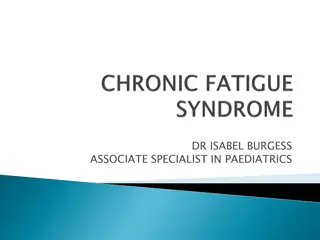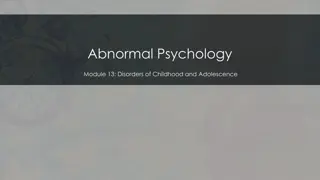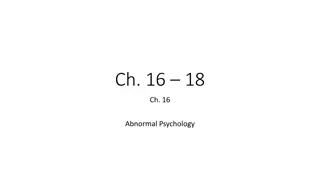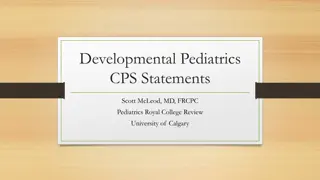Understanding Malabsorption Disorders in Pediatrics
Malabsorption disorders in pediatrics affect the digestion and absorption of nutrients, leading to symptoms like abnormal stools, failure to thrive, and specific deficiencies. Common symptoms include watery diarrhea, abdominal distention, and systemic issues like anemia and fatigue. Proper diagnosis and management are crucial in addressing these conditions in children.
Download Presentation

Please find below an Image/Link to download the presentation.
The content on the website is provided AS IS for your information and personal use only. It may not be sold, licensed, or shared on other websites without obtaining consent from the author. Download presentation by click this link. If you encounter any issues during the download, it is possible that the publisher has removed the file from their server.
E N D
Presentation Transcript
Malabsorption Dr Sawasn I. Haeeb Pediatrics department
Case study Twelve years old girl presents to the physician's office with three years history of intermittent diarrhea with loose, large, greasy, foul-smelling stools. Past history of anemia, anorexia, and minor abdominal pain. Her weight has been the same for 3 years now A diet history suggests a normal diet Exam: her vital Signs are normal. Ht 140 cm, wt 30 kg. She is thin and small for age, pale. Abdomen is slightly protuberant and hyper-resonant and flat fingernails.
Definition Malabsorption disorder affecting the digestion or absorption of nutrients, manifests as abnormal stools, failure to thrive and specific deficiencies
History Stool Systemic Symptoms GI Diet Characteristics Symptoms
amount and type of Fluids Fruit juice Fat Diet history Solid foods Formula ingested
GI tract symptoms *Abdominal distention and watery diarrhea ,Skin irritation peri-anal area (carbohydrate mal absorption ) *Periodic nausea (chronic Giardia infections) * Bloody stools (protein sensitivity syndromes or IBD) *Poor appetite (food sensitivity syndromes) *Increase in appetite (cystic fibrosis) *Systemic symptoms as F .., A ., R
SYSTEMIC SYMPTOMS Abetalipo proteinemia develop retinitis pigmentosa and ataxia folate and B-12 malabsorption result in macrocytic anemia. weakness, fatigue, and failure to thrive
Toddler's diarrhea loose stools With undigested food particles Bloody stools protein sensitivity syndromes Carbohydrate intolerance Frequent loose watery stools Giardia, enterokinase deficiency, hepatic and pancreatic dysfunction, and protein sensitivity syndromes. Pasty or loose foul- smelling stools Fat malabsorption STOOL CHARACTERISTICS
Types (1) Selective lactose malabsorption. (2) Partial .. a-Beta-lipoproteinemia (3) Total .. celiac disease
What is the most likely diagnosis? *Celiac disease *Giardiasis *Inf. bowel diseases *Lactose intolerance *cystic fibrosis
Laboratory Studies Stool analysis *Reducing substances * pH *Bile acids * Fat *Serum proteins as 1 antitrypsin *Ova and parasites * Clostridium difficile (toxins A and B) or Cryptosporidium Urinalysis *glucose level *urinary 4-hydroxy- phenylacetic acid (bacterial over growth syndrome)
Blood test - Megaloblastic anemia - Neutropenia (Shwachman-Diamond syndrome) - Acanthocytosis (Abetalipoproteinemia) - Total serum protein - Fat soluble vitamin - Calcium - ESR ,C-reactive protein - Liver function tests - IgG and IgA gliadin and IgA antiendomysial - 13C Sucrose breath test
Causes Structural defects Mucosal abnormalit y Enzyme deficiencie s Digestive failure Systemic disease Infective agents lactose intoleranc e cystic fibrosis Mal- nutrition Coeliac disease Crohn s disease TB Giardia
Medical Care (specific entity) bacterial overgrowth Celiac Disease Celiac Celiac Disease Disease bile acid mal- absorption food allergic pancreatic enzymes gluten-free diet oral broad- spectrum antibiotics elimination diet cholestyramine
Gluten-Sensitive Enteropathy (Celiac Disease)
Case study: A 2-year-old boy had a history of poor growth from 12 months of age. His parents had noticed that he tended to be crotchety and had three or four foul- smelling stool a day. What is the possible Diagnosis ?
Autoimmune inflammatory disease - small intestine Ingestion of gluten Genetically susceptible persons.
Manifestations 1-Silent 2-Classic (infancy) failure to thrive, diarrhea, abdominal distention, developmental delay, and, severe malnutrition. 3-Constitutional short stature or dental enamel defects 4-Other auto-immune syndromes 5- Anemia 6- Dermatitis Herpetiformis
Dermatitis herpetiformis, celiac disease of the skin. Vesicular, crusted, intensely pruritic lesions develop on the back
Diagnosis Serologic Tests 1) IgAantiendomysialAntibodies 2) IgAanti tissue transglutaminase (false negative with IgAdef.) 3)IgAantigliadin 4)IgG antigliadin
Indications for serologic tests 1)Patients with the classical disease 2)Increased genetic risk (family history of celiac disease or personal history of type I diabetes) 3)H/O chronic diarrhea, unexplained anemia, chronic fatigue, or unexplained weight loss
Small Intestinal Biopsy Because of patchy mucosal involvement need multiple biopsies --Villous atrophy --Crypt Hyperplasia - -Increased Intraepithelial Lymphocytes
Criteria for diagnosis ( although the diagnosis strongly suggestive by positive serology ) 1-Definitive celiac disease histological features and clinical response to glutean withdrawal 2-Supportive evidence Reverse of +ve serological test after gluten withdrawal 3-Need 3 biopsies -Iintial biopsy -Second to document healing with gluten withdrawal -Third to show recurrent damage with re-introduction of gluten
Complications 1- Osteoporosis 2-Neurologic manifestations Cerebral calcifications and epilepsy, peripheral neuropathy, postural instability, gluten ataxia 3- Refractory sprue 4- Lymphoma and bowel adenocarcinoma
Management *Wheat, barley and rye Free diet * Oats are safe *Iron and multivitamins supplementation *Calcium and vitamin D replacement *Meats, vegetables, fruit, and most dairy products
Objectives Definition, cause, physical examination, D. D and management
Case study: 8 month old child presents with a history of poor growth and chronic cough. Soon after birth, he developed respiratory distress and was admitted to the neonatal intensive care unit where he was mechanically ventilated for 1 day and discharged after 5 days. He was initially breast-fed, but due to frequent vomiting and loose bowel movements, he was changed to formula feeding.
Despite trials of different types of formulas, his clinical course was remarkable for bloating, diarrhea and failure to thrive. He developed a daily cough and some respiratory difficulty. At the age of 5 months he was hospitalized for respiratory distress and was diagnosed as having asthma.
- Most common lethal inherited disease -Autosomal recessive - Chronic respiratory infections, pancreatic enzyme insufficiency, and associated complications in untreated patients.
Clinical features Intestinal Neonates 1) meconium ileus 2) volvulus 3) intestinal atresia, perforation, and meconium peritonitis 4) delay passage of meconium 5) cholestatic jaundice
Infants and children Malabsorption Failure to thrive Intussusception (ileocecal) Rectal prolapse
Pancreatic Fat-soluble vitamin deficiency Malabsorption of fats, proteins and carbohydrates 1)Steatorrhea 2)Failure to thrive 3)Recurrent abdominal pain, and distention. 4)Anorexia ,gastroesophageal reflux.
Hepatobiliary 1) Jaundice 2) Gastrointestinal bleeding
Respiratory *Chronic or recurrent cough *Prolonged symptoms of bronchiolitis *Recurrent wheezing and pneumonia *Atypical asthma, pneumothorax, hemoptysis *Digital clubbing *Recurrent sinusitis, nasal polyps *Hemoptysis
Pathophysiology Trans-membrane conductance regulator (CFTR)
Diagnosis Typical pulmonary Gastrointestinal tract Family history Positive results on sweat test
Sweat test The chloride reference value is less than 40 mEq/L, and a value of more than 60 mEq/L is consistent with a diagnosis of CF Chest radiograph Marked hyperinflation, peribronchial thickening, and bilateral infiltrates with evidence of bronchiectasis especially of the upper lobes.
Sinus radiography Pan pacification of the sinuses is present in almost all patients
Genotyping CFTR gene are amplified from genomic DNA by polymerase chain reaction (PCR)
Medical Care Multi-systemic involvement Treatment and follow-up care at specialty centers patient/parent education Airway clearance techniques Use of equipment (eg, nebulizer, spacer for metered-dose inhaler),
Surgical Care 1)Respiratory complications pneumothorax, hemoptysis, nasal polyps, or persistent and chronic sinusitis. 2)Gastrointestinal tract complications meconium ileus, intussusception, gastrostomy tube ,rectal prolapse) 3)Lung transplant
A high-energy and high-fat diet A normal diet with additional energy and unrestricted fat intake is recommended. Fat soluble vitamin Mineral supplementation
Activity: Regular exercise increases physical fitness Treatment (1)Respiratory infection (2) Clearing airways (3) Nutritional therapy ,enzyme supplements, multivitamin and mineral supplements (4)Managing complications (5) Pancreatic enzyme
Prognosis: -Improved (remains a life-limiting disease) -Median survival age is 36.8 years. -Higher in males Severity of pulmonary disease determines prognosis and ultimate outcome
8 month old child presents with a history of poor growth and a chronic cough. Soon after birth, he developed respiratory distress and was admitted to the neonatal intensive care unit where he was mechanically ventilated for 1 day and discharged after 5 days. He was initially breast-fed, but due to frequent vomiting and loose bowel movements, he was changed to formula feeding.
Despite trials of different types of formulas, his clinical course was remarkable for bloating, diarrhea and failure to thrive. He developed a daily cough and some respiratory difficulty. At the age of 5 months he was hospitalized for respiratory distress and was diagnosed as having asthma.
Exam: VS T. 37.0 C. P120, R45, BP 80/60, oxygen saturation 97% in room air, weight 6.7 kg (<5th percentile). He is alert and active in no distress. ENT exam is significant for bilateral otitis media and mild nasal congestion. Heart regular. Lungs with good aeration and mild wheezing and rales. Abdomen soft, non-tender. Enumerate 3 investigations.


